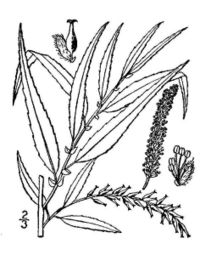Salix nigra: Difference between revisions
No edit summary |
No edit summary |
||
| Line 1: | Line 1: | ||
{{Inc| | |||
Salix nigra, Marsh. Black Willow. Fig. 3526. Tree, 30-40 ft. high: bark flaky, often becoming shaggy: twigs brittle at base: buds small: lvs. lanceolate, green both sides, finely and evenly serrate: aments 1-2 in. long; scales oblong, deciduous; stamens 3-6; ovary ovate-conical, glabrous; style short but distinct. E. N. Amer. Var. falcata, Pursh. Lvs. elongated, narrow and falcate. | |||
}} | |||
{{Taxobox | {{Taxobox | ||
| color = lightgreen | | color = lightgreen | ||
Revision as of 12:10, 30 April 2009
| Standard Cyclopedia of Horticulture |
|---|
|
Salix nigra, Marsh. Black Willow. Fig. 3526. Tree, 30-40 ft. high: bark flaky, often becoming shaggy: twigs brittle at base: buds small: lvs. lanceolate, green both sides, finely and evenly serrate: aments 1-2 in. long; scales oblong, deciduous; stamens 3-6; ovary ovate-conical, glabrous; style short but distinct. E. N. Amer. Var. falcata, Pursh. Lvs. elongated, narrow and falcate.
|
| Black Willow G5 Fossil range: {{{fossil_range}}}
| ||||||||||||||||||||||||||||||||||||||||||||||||||||||||||||||||||
|---|---|---|---|---|---|---|---|---|---|---|---|---|---|---|---|---|---|---|---|---|---|---|---|---|---|---|---|---|---|---|---|---|---|---|---|---|---|---|---|---|---|---|---|---|---|---|---|---|---|---|---|---|---|---|---|---|---|---|---|---|---|---|---|---|---|---|
 | ||||||||||||||||||||||||||||||||||||||||||||||||||||||||||||||||||
| Plant Info | ||||||||||||||||||||||||||||||||||||||||||||||||||||||||||||||||||
| ||||||||||||||||||||||||||||||||||||||||||||||||||||||||||||||||||
| Scientific classification | ||||||||||||||||||||||||||||||||||||||||||||||||||||||||||||||||||
| ||||||||||||||||||||||||||||||||||||||||||||||||||||||||||||||||||
| [[{{{diversity_link}}}|Diversity]] | ||||||||||||||||||||||||||||||||||||||||||||||||||||||||||||||||||
| {{{diversity}}} | ||||||||||||||||||||||||||||||||||||||||||||||||||||||||||||||||||
| Binomial name | ||||||||||||||||||||||||||||||||||||||||||||||||||||||||||||||||||
| Salix nigra Marsh. | ||||||||||||||||||||||||||||||||||||||||||||||||||||||||||||||||||
| Trinomial name | ||||||||||||||||||||||||||||||||||||||||||||||||||||||||||||||||||
| {{{trinomial}}} | ||||||||||||||||||||||||||||||||||||||||||||||||||||||||||||||||||
| Type Species | ||||||||||||||||||||||||||||||||||||||||||||||||||||||||||||||||||
| {{{type_species}}} | ||||||||||||||||||||||||||||||||||||||||||||||||||||||||||||||||||
| {{{subdivision_ranks}}} | ||||||||||||||||||||||||||||||||||||||||||||||||||||||||||||||||||
| [[Image:{{{range_map}}}|{{{range_map_width}}}|]] | ||||||||||||||||||||||||||||||||||||||||||||||||||||||||||||||||||
| Synonyms | ||||||||||||||||||||||||||||||||||||||||||||||||||||||||||||||||||
| {{{synonyms}}} |
Salix nigra, commonly known as the black willow, is a tree species native to eastern North America. It is present from Nova Scotia and southern Ontario, west to Nebraska and southeastern Arizona and south to Florida and northeastern Mexico. The largest American species of willow, it is typically found along streams and in swamps, hence it is also known as the swamp willow (not to be confused with Salix myrtilloides). Goodding's willow (Salix gooddingii) is sometimes considered a variety of the black willow, which would extend its range to western North America.
Description
It is a small to medium-sized deciduous tree, growing to 20-30 m in good conditions, exceptionally up to 40 m. It has long, thin leaves, 7-13 cm long and 1-2 cm broad, dark, shiny green color, with a lighter green underside. It is dioecious, with small, green flowers that are borne on catkins 2.5-7.5 cm long. The fruit is a 5 mm capsule which splits open when mature to release the numerous minute, down-covered seeds.
Uses
Black Willow roots are very bitter, and have been used as a substitute for quinine in the past. The Great Lakes Ojibwe used the young branches and twigs to make baskets and other parts were used to treat indigestion.